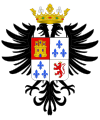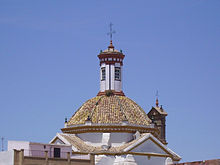- Montalbán de Córdoba
-
Montalbán de Córdoba — Municipality — 
Flag
Coat of armsLocation in Spain Coordinates: 37°35′N 4°45′W / 37.583°N 4.75°WCoordinates: 37°35′N 4°45′W / 37.583°N 4.75°W Country  Spain
SpainAutonomous community  Andalusia
AndalusiaProvince Córdoba Comarca Campiña Sur Judicial district Montilla Founded unknown Government – Alcalde José Cañero Morales (2007) (IU) Area – Total 33.66 km2 (13 sq mi) Elevation 273 m (896 ft) Population (2008) – Total 4,626 – Density 137.4/km2 (356/sq mi) Demonym Montalbeño /-a Time zone CET (UTC+1) – Summer (DST) CEST (UTC+2) Postal code 14548 Dialing code (+34) 957 31X XXX Official language(s) Website Official website Montalbán de Córdoba is a town in the province of Córdoba in Andalusia, southern Spain. The town is 42 km from Córdoba, the capital of the province.
Contents
History
- Prehistory: Remnants of pottery were found 4 km to the south of the town. At present they are in the archaeological museum of Cordoba.
- 3rd century BC: Near Montalban was an old Roman city known as Segovia.
- 210 BC: Romans and Carthaginians fought in a battle in the Second Punic War.
- 45 BC: Julius Caesar and Pompey's sons fought in a battle in Caesar's civil war. Segovia vanishes from the historical record.
- 4th century to 5th century: Ruins and a catacomb are found in Tentecarreta 2 km from the town.
- 1530: Fernandez of Cordoba established Montalban.
- 1668: Montalban had a population of 1040.
- 1808-1812: French invaders burn the municipal file of Montalban and the history of the town is lost.
- 1880: Montalban had a population of 3000.
- 1910: Montalban had a population of 3300.
- 1960: Montalban had a population of 4700, but shrunk to 3800 due to emigration.
Demographics
Number of inhabitants in the last ten years:[1]
1999 2000 2001 2002 2003 2004 2005 2006 2007 2008 4.573 4.558 4.561 4.510 4.520 4.609 4.602 4.621 4.646 4.626 Representative buildings and places of interest
El Calvario
"El Calvario" is in the south of Montalbán, inside the town, though it used to be outside the town. The first Calvario hermitage was a small church in the outside of Montalbán, near old castle ruins, built circa 1590. The current church was built on 1690 and was reformed several times. The current appearance is from the 18th century, and the dome was built 1850. Her style is neoclassic, with dome and belfry. The Calvario hermitage is white. The floor is Greek cross, with an altarpiece, where Nuestro Padre Jesús del Calvario is in the sevillian style. The roof of the dome has a cylindrical torch.
Madre de Dios Hermitage
 Madre de Dios Hermitage.
Madre de Dios Hermitage.
This church was declared a historic artistic monument in 1981, and a historical heritage of Andalusia in 1996. It is a three nave church, located on the corner of Madre de Dios street and Ancha street. This church was called Nuestra Señora de los Remedios from the 16th century to 1850. At present the church is closed and often doesn't celebrated worships.
Santa María de Gracia Church
This church is a parish church situated in the Andalusia's square, in front of the town hall. The church is oval, and it is made of brick. Inside, it has a little altar dedicated to the Inmaculada, pieces of baroque altarpiece and ruins of the old church. It has pieces of goldsmithery from the old church built into the parish cross, silver's monstrance and the shrine's door. The old church was demolished on 1964. The church appears to be built in the style of the 14th century, of decadent ogival style. It was 25 m long, 17 m broad and 10 m high. It has three naves. The sides were vaulted and the central nave was coffered. The church had more than a dozen altars. The main altar was made by Gaspar Lorenzo de los Cobos in 1724. The church had two entry doors, a front door and other in the right back, both with ogival arch. It also has a beltry with four bells and a rich patrimony of goldsmithery.
Culture House
This building was built on La Paz Street in 1984, when the democratic town hall arrived. It has two floors, with a total area of 250 m2. It served as the town hall while the new town hall was built. The culture house has the library, adult education, lectures and social gathering, public and official ceremonies, general presentation and cultural activities. At present the second floor is the municipal library, while the first floor is the adult education and the main hall.
Library
The library was inaugurated in 1986. Until 1990 the library was situated on the second floor of the old medical center, at present the Office for Youth Information ("Oficina de Informacion Juvenil"). At that time, the library had 1300 volumes. On 1990, the library was moved to the second floor of the culture house. At this the library has over 7000 volumes.
Tentecarreta Catacombs
Tentecarreta is 2 km from Montalban. Large underground galleries were found in Tentecarreta, which served as a necropolis during the 4th and 5th centuries. These galleries form catacombs. The catacombs were rare in the Roman empire, and the catacombs of Montalban are the only such catacombs in Spain. Tentecarreta has two cross galleries oriented according to the cardinal points. The galleries are narrows and tortuous, and are heavily eroded due to humidity, collapses and avalanches of mud. The south gallery housed a collective burial.
El Mesto
The Mesto is an old tree, hybrid between evergreen oak and cork oak, around 7 km from Montalban. During the 8th century it gave shade, shelter and rest to the peasants and travellers. The old tree measured 15 m. A large hollow was made in its trunk, where the people made fire, severely damaging the tree. On 1980, an association was founded for its defence. The Mesto served as inspiration to writers and artists and the tree promoted a special sensibility. The Mesto was demolished in the summer of 1995. The Mesto stays a symbol, a feeling and a memory of something lost.
Parties
August Fair
The fair is celebrated during August 6-8, in honour of Nuestro Padre Jesús del Calvario. During this time the main agricultural processes are finished.
Romería
The pilgrimage is celebrated on May 15 in honour of Saint Isidore the Laborer. Almost everyone goes up to Huerta Dios, a distance of around one kilometre. For around half the morning, there is a procession headed by the coach of Saint Isidore's followers, followed by other coaches, hersemen, typical suits, etc.
Notes
- ^ "Instituto Nacional de Estadística". http://www.ine.es/. Retrieved 28 July 2009. (Spanish)
External links
- Page of City Council of Montalbán de Córdoba
- Page of Campiña Sur's comarca
- Montalbán de Córdoba, Multiterritory Information System of Andalusia
- International Fair of Garlic of Montalbán de Córdoba
Categories:- Municipalities in Córdoba
Wikimedia Foundation. 2010.



